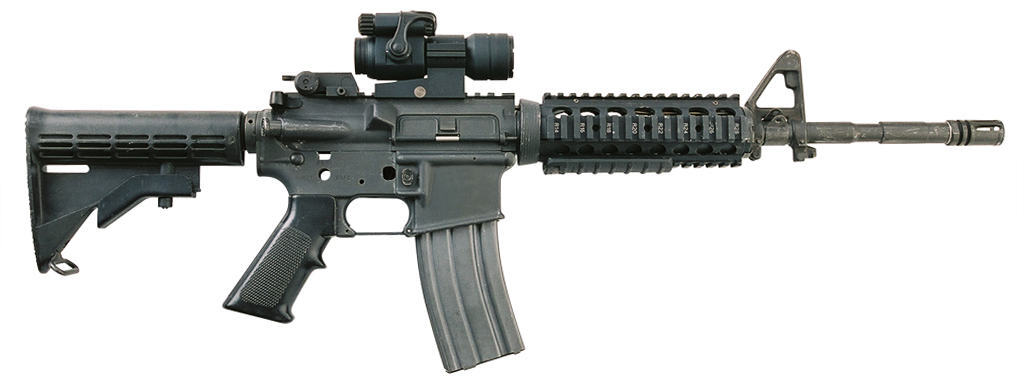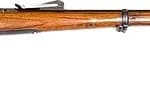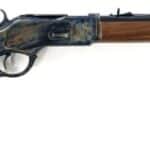
Below is an in-depth review of the article on the M4 Carbine, examining its factual accuracy, depth, richness, and authority.
Overview and Structure
The article provides a concise historical and technical overview of the M4 Carbine. It is organized into clear sections—starting with an introduction to the M4, then outlining its development, manufacture, operational use, cartridge performance, a look at its predecessors and related battle rifles, and concluding with a summary of its significance. This logical structure makes it easy to follow the evolution of the firearm and understand its role in modern military operations.
Factual Accuracy
Historical Context and Development
The article correctly identifies the M4 Carbine as an offshoot of the M16 rifle and places its introduction in the early 1990s with official adoption around 1994. It accurately notes that the M4 was developed to provide a more compact and maneuverable alternative to the longer M16, especially for close-quarters combat, vehicle operations, and airborne deployments. This is consistent with historical records that document the U.S. military’s shift towards a lighter, more versatile rifle during the late 20th century.
The article also correctly credits Eugene Stoner and ArmaLite for the original M16 design—a key detail in the development history of American assault rifles. However, while the article mentions Colt’s role in purchasing the design rights in 1959 and later in developing variants such as the Colt Commando, it could have provided more nuance regarding the evolution of design improvements that led to the modern M4 variant. Although the summary is broadly accurate, a deeper exploration into the transition from prototypes like the Colt Commando to the standardized M4 would enhance the historical narrative.
Production and Contractual Details
The discussion on manufacturing states that Colt held an exclusive contract until 2013, after which FN Herstal and Remington Arms were awarded production contracts following a legal dispute. This section is generally accurate regarding the U.S. military’s efforts to diversify its supply chain. However, the narrative around manufacturing contracts is somewhat simplified. In practice, the procurement and production history of the M4 has involved a complex interplay of competitive bidding, contractual adjustments, and multiple manufacturers over time. A more detailed account would mention additional stakeholders and clarify that the landscape of production has evolved, with various companies contributing to the overall supply of M4-type carbines to different branches of the U.S. military and international clients.
The claim that around 8 million M4 rifles have been manufactured provides a rough estimate that is consistent with widely circulated figures. However, such numbers should ideally be contextualized with a discussion of variations (such as the M4A1 and other derivative models) and potential discrepancies among sources.
Operational Use and Performance
The article outlines the M4’s service history accurately. It notes its first major deployment during Operation Joint Guard in Bosnia and Herzegovina, followed by extensive use in conflicts such as the Iraq War and the ongoing operations in Afghanistan. This aligns with documented military history, where the M4 Carbine has indeed been widely adopted as the standard issue rifle for many U.S. military units.
Regarding technical performance, the article correctly identifies the 5.56×45mm NATO cartridge as the standard ammunition and mentions a muzzle velocity of approximately 3,000 feet per second. These technical specifications are in line with published data. The discussion about effective range—citing roughly 500 meters for a point target and 600 meters for an area target—matches many military field manuals and performance evaluations. However, the article might benefit from a more nuanced treatment of these figures, discussing factors such as barrel length, environmental conditions, and the differences in performance between full-automatic and burst-fire modes.
Comparison with Other Firearms
In its brief comparison with other battle rifles such as the British L85A2, the German Heckler & Koch G36, and the Russian AK-74M, the article presents accurate generalizations. For instance, noting that the L85A2 addressed earlier reliability issues, that the G36 employs a short-stroke piston system instead of direct impingement, and that the AK-74M is famed for its durability and ease of use are all factually correct. These comparisons help situate the M4 within a broader context of modern military firearms.
Depth and Richness
Historical and Technical Background
The article offers a broad yet accessible history of the M4’s development, linking it to the legacy of the M16 and earlier designs. It provides enough background for readers to understand why a shorter carbine was developed in the first place, emphasizing the need for greater mobility in modern combat scenarios. This historical context is essential for appreciating the evolution of military small arms.
However, the article could be enriched by delving into additional technical details. For example, it might describe the specific design changes that differentiate the M4 from its predecessor, such as the differences in barrel length, the incorporation of a collapsible stock, and improvements in modularity that allow for accessory mounting. Details on the evolution from the M4 to the M4A1 variant—featuring full-automatic fire capability—would provide further depth and acknowledge developments that address soldiers’ needs in various combat environments.
Manufacturing Process and Variants
While the manufacturing section touches on key milestones in production history, it lacks an in-depth discussion of the manufacturing process itself. Information about the challenges involved in mass production, quality control measures, or the technical differences among production lines could further enhance the article’s richness. Moreover, a more detailed look at the various variants of the M4 (such as training models, export models, and the M4A1) would help readers understand how the platform has been adapted over time to meet different operational requirements.
Operational Performance and Field Feedback
The article’s discussion of the M4’s operational use is factually correct but could be deepened by including insights into field performance. For example, incorporating assessments from soldiers, documented reports on reliability and maintenance, and a discussion on the weapon’s ergonomics would add layers of richness to the account. The balance between effective range and maneuverability, while mentioned, could be expanded upon with explanations of how soldiers balance these factors in urban versus open-field environments.
Comparative Analysis
The brief section comparing the M4 with other battle rifles is valuable, but it remains at a high level. A richer analysis could include specific performance metrics, differences in handling characteristics, and a discussion on the respective maintenance and logistical considerations of these weapons. Such a comparison would not only provide additional context for the M4’s place in military history but also enhance the article’s authority by drawing on more detailed, empirical data.
Missing Details and Opportunities for Enrichment
The article, while comprehensive in its overview, does omit several opportunities for further depth:
- Technical Innovations: A more detailed explanation of the direct impingement gas system versus piston-operated systems would offer readers a clearer understanding of the operational mechanics that distinguish the M4 from other designs.
- Operational Adaptations: The evolution of accessory rails (such as the Picatinny rail) and the incorporation of modern optics, laser aiming modules, and other attachments could be explored to show how the M4 has remained adaptable to changing combat technologies.
- Field Modifications and Upgrades: Many militaries have introduced modifications and upgrades to the M4 platform over the years. Discussing some of these improvements—such as enhanced materials for reduced weight, upgraded trigger systems, or improved recoil mitigation techniques—would add depth and highlight the weapon’s continuous evolution.
- Training and Doctrine: An exploration of how training doctrine has adapted to the use of the M4 would further illustrate the platform’s impact on modern military tactics and strategies.
Authority of the Article
Source Credibility and Expertise
The article is written in a manner that suggests a good working knowledge of military firearms. It references historically significant figures (like Eugene Stoner) and correctly places the M4 within the broader narrative of U.S. military small arms development. The discussion of technical aspects—such as cartridge specifications and effective range—demonstrates familiarity with the subject matter.
That said, the article would gain authority by citing its sources or referencing specific military documents, field manuals, or reputable defense publications. The absence of such citations means that while the content is generally accurate, the reader must take the information at face value without a clear pathway to verify details. Adding references to well-known sources (such as U.S. Army technical manuals, defense analysis reports, or publications from defense industry experts) would greatly bolster its credibility.
Balanced Coverage
The article presents a balanced view of the M4 Carbine by discussing both its strengths—mobility, modularity, and adaptability—and its trade-offs, such as a reduced effective range compared to the M16. This balanced approach enhances its authority, as it does not shy away from noting that improvements come with certain compromises. However, the review could be further strengthened by acknowledging some of the criticisms or limitations that have been raised by military analysts over the years. For example, debates over the reliability of the direct impingement system in harsh environments or issues related to long-term durability under sustained combat conditions would present a more complete picture.
Clarity and Precision
The language used in the article is clear and precise, making it accessible to a wide audience—from military enthusiasts to professionals in the defense sector. The technical details are presented in a manner that is both informative and straightforward. However, for a reader seeking an authoritative, in-depth analysis, the inclusion of more technical diagrams, data tables, or references to field test results would add a layer of rigor that currently remains at a descriptive level.
Overall Observations
Strengths
- Historical Context: The article does an effective job of tracing the development of the M4 Carbine from its M16 origins. It highlights the evolution in response to changing battlefield requirements and provides a clear timeline from conceptualization to widespread adoption.
- Technical Accuracy: Most of the technical details—including cartridge specifications, muzzle velocity, and effective range—are correct and align with established knowledge about the M4.
- Comparative Perspective: By mentioning other rifles such as the L85A2, G36, and AK-74M, the article situates the M4 within the broader context of modern military small arms, offering a comparative perspective that enriches the reader’s understanding.
- Clarity and Organization: The clear division of topics and the logical flow of the narrative make the article accessible and easy to follow.
Areas for Improvement
- Depth of Technical Analysis: While the article covers the basics well, it could benefit from a more detailed technical analysis. Explaining the intricacies of the direct impingement system, the specifics of accessory integration, and the differences between various M4 variants would provide a richer, more in-depth understanding.
- Manufacturing and Contract Nuances: The discussion of manufacturing contracts and production history is somewhat simplified. A more nuanced account that details the competitive bidding process, changes in production practices, and the roles of additional manufacturers would enhance the article’s factual depth.
- Source Citation: The authority of the article would be significantly bolstered by including references to reliable sources such as military manuals, technical reports, or expert analyses. This would not only support the factual claims made but also provide interested readers with pathways for further research.
- Operational Feedback: Including insights from soldiers or field reports on the M4’s performance under different combat conditions would add practical, real-world perspectives. Such firsthand accounts or documented evaluations would enhance the overall richness of the narrative.
Conclusion
In summary, the article on the M4 Carbine provides a well-organized and generally accurate overview of one of the U.S. military’s most important small arms. It captures the essential historical evolution from the M16 to the M4 and outlines key technical specifications and operational uses. The presentation is clear and accessible, making it suitable for readers who are looking for a basic to intermediate understanding of the weapon’s development and significance.
While the factual content is largely correct—with proper identification of key figures, timelines, and performance metrics—the article could be enhanced by delving deeper into technical details, manufacturing nuances, and operational feedback. Adding references or citations to authoritative sources would further elevate its credibility and allow for a more rigorous discussion of the subject matter.
Overall, the article is a commendable introductory piece that offers both historical context and technical insights. With further elaboration in certain areas, it could serve as an even more robust and authoritative resource on the evolution, performance, and impact of the M4 Carbine in modern military history.
Read more here:
If you know of any forums or sites that should be referenced on this listing, please let us know here.







